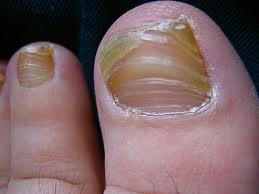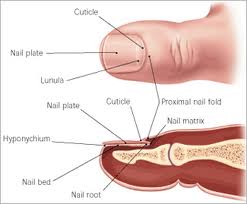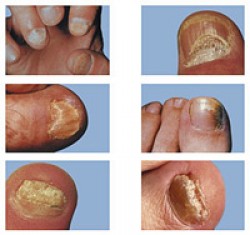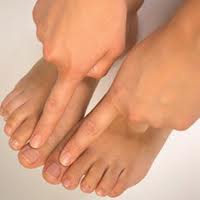Posts Tagged ‘fungal nail infection’
What are the symptoms of a Nail fungus and how can I tell if I have a Nail Fungus Infection?
What are the symptoms of a Nail fungus and
how can I tell if I have a Nail Fungus Infection?
 You’d think these would be fairly straightforward questions that ought to illicit simple answers. Unfortunately not only is this not true, but it is confusing enough that sometimes doctors misdiagnose nail fungus (or onychomycosis). Knowing the symptoms will assist you in helping your doctor to order the appropriate diagnostic tests so that you end up with the correct solution to your problem.
You’d think these would be fairly straightforward questions that ought to illicit simple answers. Unfortunately not only is this not true, but it is confusing enough that sometimes doctors misdiagnose nail fungus (or onychomycosis). Knowing the symptoms will assist you in helping your doctor to order the appropriate diagnostic tests so that you end up with the correct solution to your problem.
There are two basic causes of nail infections. Bacterial and fungal. Onychomiycosis, or fungal nail infection, is usually caused by a dermatophyte called Trichophyton rubrum. If not, it is caused by Candida albicans, a yeast growth (also a fungus). As nail infections differ in variety and in cause, the correct cure must be applied. A fungal infection should be treated with an anti-fungal whereas a bacterial infection should be treated with an antibiotic.
Onychomycosis affects the nail bed (skin underneath the nail) nail plate (the hard surface that we refer to as the nail) or the skin around the nail. About one third of skin infections and half of nail infections are caused by Onychomycosis. The visual signs are the abnormalities caused by the nail fungus. A white or yellowish crust appears on top of or embedded in the nail. This is the actual fungus growth. Sometimes it appears as streaks that follow the line of the nail against the infected digit (finger or toe) and sometimes it appears at the cuticle (soft area at the base of the nail). As the fungus spreads, it covers the entire surface of the nail, turning it to a milky white or yellow. Frequently it causes the nail to become ridged and deformed. This is a result of the dermaptophytes emitting destructive waste product as a result of consuming keratin. If the fungus gets underneath the nail plate, it can cause the nail bed to become irregular. This causes the nail plate to release from the bumpy nail bed and the nail becomes loose and can fall off.
If the nail fungus infection becomes severe, or if it contains Candida, the area around the nail can become swollen and sensitive to the touch. The skin may express (think ooze) pus and be very uncomfortable, even painful. These are common signs of infection. The pus is a result of white blood cells rushing to the area to fight off the infection. This is your body trying to do its job and tell you and your doctor that something is wrong.
It is most common for pus to be present in the case of bacterial infections. Thus your doctor should check for this before looking for fungal infections. To add to the confusion, there are diseases that mimic a nail fungus, including hallopeau acrodermatitis, lichen planus, nail bed psoriasis (which can occur in conjunction with fungal infection of the nail), nail bed melanoma, Reiter syndrome, yellow nail syndrome, onycholysis, and paronychia. Because of this factor, more than one test may be necessary to determine the correct course of treatment.
Different forms of onychomycosis will require different samples from the affected area. In some cases the nail can be sampled from the end or the top can be scraped for a sample, in others, the nail will need to be removed entirely. Whereas this can be a bit scary, it is also to your advantage as it then exposes the nail bed so that it can be treated.
The most typical tests performed on a nail culture to look for onychomycosis are a potassium hydroxide wash, which allows for the sample to be put under a microscope and searched for evidence of fungal growth, or a fungal culture, where the sample piece of nail is put in an environment (usually a petri dish) where it has the necessary components to thrive and create new growth, thus showing what kind of fungal infection it is. In the unlikely event that neither of these tests show positive for onychomycosis, the remaining nail sample can be pulverized and sent to a pathology lab for analysis or submitted for a bacterial culture if it is determined that the infection is bacterial instead of fungal.
Determining what kind of infection you have and what to do about it are very important when dealing with a nail infection of any kind. Having the infected area looked at by a physician, preferably a dermatologist, is the best way to deal with these diseases as they can help to rule out and diagnose serious problems as well as knowing what to do about the infection in the first place.
What You Need To Know About Toenail Fungus
What You Need To Know About Toenail Fungus
 Toenail fungus infections are all caused by a fairly common set of conditions that can affect up to 12% of the American population. A fungus is a living organism that enjoys dark, damp places. Because of this, most people get a fungal nail infection in their toes. It does sometimes occur on fingernails, but as the feet offer a much more hospitable environment, that is the most sought after area for these little life-forms. The fungus can live along side the nail, or burrow underneath the nail. There are several factors that determine where the infection is actually located, two of which are the progression and severity of the infection.
Toenail fungus infections are all caused by a fairly common set of conditions that can affect up to 12% of the American population. A fungus is a living organism that enjoys dark, damp places. Because of this, most people get a fungal nail infection in their toes. It does sometimes occur on fingernails, but as the feet offer a much more hospitable environment, that is the most sought after area for these little life-forms. The fungus can live along side the nail, or burrow underneath the nail. There are several factors that determine where the infection is actually located, two of which are the progression and severity of the infection.
Doctors have noticed that a the beginning of an occurrence, it is most likely that the fungus lives along side the nail and gradually works its way underneath the nail to the nail bed as the infection progresses. Early symptoms of a fungal nail infection include a white or yellowish spot on the nail. As pain or discomfort are not common at this stage of infection, most people don’t notice the problem until it has progressed further.
As the infection develops, things become a bit more noticeable, even if these changes happen slowly. The nail dulls and gradually becomes yellowed and sometimes the toenail changes its shape. This is caused by the thickening of the nail and potential crumbling at the edges as it becomes more brittle and frail. The thick, yellowing, ridged nail is the trademark of the condition. This is when people tend to feel discomfort from the infection, sometimes caused by the nail separating from the nail bed.
If you allow this condition to progress sufficiently that your toenail separates from the nail bed, exposing the soft skin below, it is possible that this can result in further, and more serious, infection. If you see pus oozing from your toe, or if there is a bad odor when you take off your sock, it is now time to go see your doctor, immediately.
The myth about the toenail fungus microorganism is that it is only found in dirty places. Much like its cousin, the mushroom, this microorganism is happy to breed wherever and whenever it can. If its living conditions are correct, it will be there and will inevitably come into contact with hands and feet that it will send its spores onto to continue increasing the population. This is a fungus that everyone comes into contact with daily. Infection occurs when you give the fungus an environment in which it can thrive.
The medical community refers to this particular fungus as dermatophytes. While there are other causes of nail fungus infection, including yeast and mold, dermatophytes are the most common culprit.
There are things that may make a person more susceptible to toenail fungus, such as:
- An unhealthy immune system
- Peripheral artery disease
- Trauma to the foot, especially if the toenail has been damaged
- Abnormal skin pH
- Poor hygiene
- Previous fungal nail infections
It is unlikely that a fungal nail infection will become life threatening or debilitating. However they can cause pain and discomfort as well as affect a person’s self esteem because of the appearance of the nail. Because treating toenail fungus can be difficult, doing your best to prevent infection is the most effective cure. If you are concerned that you have an infected toenail, consult with your health care provider. Between the two of you, the state of your foot health can be determined and a course of action can be enacted.
Easily Applied Home Nail Fungus Remedies
Easily Applied Home Nail Fungus Remedies
 Having unattractive toenails is embarrassing and even humiliating. There are many ways to solve this incredibly common problem.
Having unattractive toenails is embarrassing and even humiliating. There are many ways to solve this incredibly common problem.
How Does My Nail Become Infected?
Toenails come into contact with microorganisms that get onto the skin, the nail sheath and underneath the nail to the nail bed. Any and all of these places can easily become a hotbed (literally) for infection. Once you have contracted a fungal infection, it can be very difficult to cure.
As these microorganisms are fungal spores, they thrive in places that have no light and high humidity. This makes the feet very susceptible to infection because we are all accustomed to wearing shoes. Especially because many people wear the same pair of shoes day in and day out, not allowing time for them to dry and air between wearings.
Trimming your toenails too close to the skin can cause accidental cuts, providing another entry point for these fungal spores.
Shoes that fit to tightly can also be a cause of toenail fungus infection as they leave no room for your feet to breath and they can cause the breakdown of the nail where they rub, leaving an opening for the fungus to invade.
Standard Symptoms of Nail Fungus Infection
Here are some very simple ways to recognize a toenail fungus infection:
- A discoloration of the toenail, white to yellow
- The nail becomes thick and disfigured
- A stinging pain from under and around the nail
- Brown or black spots developing on the nail
- Parts of the nail crumble or flake off
- A foul odor coming from the nail
- Oozing pus from around the nail
- Toenail falling off entirely
Recommended Home Remedies for Fungal Nail Infection
The faster you catch a fungal nail infection, the easier it is to get rid of it. The early stages can be treated with any of the remedies listed below:
- ClearFungus – This is the leading natural remedy for curing toenail fungus. This is considered more of a natural product anti-fungal treatment than a home remedy as it is specially formulated to kill toenail fungus and promote new nail growth.
- Vicks VapoRub – Although no one quite understands why, Vicks VapoRub seems to prove very effective at stopping the growth of fungal infection. It does not kill the fungus but does inhibit growth, which can encourage healthy nail growth until the infection has been trimmed entirely away. No studies have been done on this but many people swear by it.
- Hydrogen Peroxide, Listerine and Rubbing Alcohol – Combined or separately, all of these chemicals have been shown to have some effect on nail fungus as they all posses antiseptic properties. Soak your toenails in your choice of these solutions (again, combined or separately) for twenty minutes, two times a day.
- Tea Tree Oil – This is a powerful essential oil that contains antiseptic and antifungal components. Wash and thoroughly dry the foot, then rub the affected nail(s) and surrounding skin with Tea Tree Oil twice a day.
- Vinegar – Soaking your toes in a solution of equal parts vinegar and water in a large tub or bowl for 20-30 minutes, then washing and thoroughly drying your feet until the infection has cleared.
These remedies are good for stopping the infection early on. If you follow these instructions closely and stick to the regular process, you should be able to clear up your infection by yourself. If your symptoms are bad to begin with, or if they worsen, seeking the help of a medical professional will become necessary.
A Doctor’s Detailed Description of Onychomycosis
A Doctor’s Detailed Description of Onychomycosis
 Onychomycosis is the medical term for a fungal infection of the fingernails or toenails. Onycho refers to the nail, mycosis refers to fungal infection. This condition represents about 33% of all fungal skin infections. Approximately half of all diagnosed diseases of the fingernails or toenails are onychomycosis.
Onychomycosis is the medical term for a fungal infection of the fingernails or toenails. Onycho refers to the nail, mycosis refers to fungal infection. This condition represents about 33% of all fungal skin infections. Approximately half of all diagnosed diseases of the fingernails or toenails are onychomycosis.
Onychomycosis usually occurs in older people, most commonly 40 and above. The likelihood of the disease occurring in adults rather than children is about 30%. Onychomycosis is a regularly occurring disease and the chances of contracting it increase as people age. Approximately 20% of all people between the ages of 40 and 60 have onychomycosis. It is thought that upwards of 90% of elderly patients have it.
Onychomycosis occurances
Onychomycosis occurs more regularly in men than in women, however women are more likely to contract a specific type of the fungus called Candida. The disease seems to have no preference in race. There has been an increase in the number of cases of onychomycosis in recent years. Doctors believe this has to do with people living longer, thus facing the greater probability of diseases that are common causes of onychomycosis. For instance, the level of diabetes has increased in the population as well. The same corollary can be drawn between the aging population and the number of people with diabetes. Interestingly enough, having diabetes makes it more likely that a patient will contract onychomycosis as diabetics have a harder time fighting off infection and healing from wounds. Poor circulation is another commonly related disease as people who suffer from this have a less healthy immune system.
The most common symptom and complaint of sufferers of onychomycosis is the disfiguration of the nail. One of the greatest difficulties in catching a fungal nail infection early on is that it doesn’t present serious symptoms, especially in the beginning, when it is easiest to cure.
The fact that onychomycosis disfigures the nail is not to be disregarded. It causes people to avoid certain social interactions because of the embarrassment they feel having a nail fungus will bring. They become concerned that a fungal infection is infectious or that they will be seen as “unclean” or “unhealthy”. It is of serious concern to doctors, the psychological and emotional effect that onychomycosis can have on people.
Although this disease starts as a series of cosmetic symptoms, if left unchecked it can develop into a far more serious set of problems. Pain in the affected finger or toe can occur. Because the nail thickens, it deadens the sensitivity in the affected digits. This can lead to loss of sensation and therefore ability in the hands and feet. Tasks like writing and other daily activities are affected by fingernail fungus, being able to sense the floor, causing difficulty with walking and even causing serious falls, are an advanced symptom of toenail fungus. For patients who are already affected by diseases that cause problems with the nerves in the legs, this can make things even worse.
There are four main types of onychomycosis:
- Distal subungual onychomycosis – This is the most common form of onychomycosis and is caused by a dermatophyte called Trichophyton rubrum. What happens is the dermatophyte penetrates the nail plate and buries itself in the nail bed. The term ‘subungual’ refers to underneath the nail. The infection manifests as a whitish-yellow growth under and on the nail towards the tip (the part you trim) This then works its way down toward the cuticule and underneath to the nail bed. The nail becomes thick, pitted, ridged and can start to crumble.
- Proximal subungual onychomycosis – starts at the cuticle end of the nail instead of at the tip. It then works its way up the nail and under the nail as the nail grows out. This form of nail fungus infection occurs more regularly in people who have issues with immune deficiency. Proximal subungual onychomycosis is caused by Trichophyton ruburm, just as distal subungual onychomycosis is, but it is also caused by other fungi and molds.
- White superficial onychomycosis – This is probably the least commonly occurring form of onychomycosis, happening in only 1 of 10 cases on average. This fungus develops on the top of the nail or in its topmost layers. As the name ‘white superficial’ would imply, this is a lesion that forms at the top of the nail and is white in color. Gradually, the fungus will take over the entire nail if left unchecked. Unlike most other forms of onychomycosis, white superficial onychomycosis is caused by Trichophyton mentagrophytes, a different dermatophyte.
- Candida onychomycosis – This final form of onychomycosis starts out its life as chronic mucocutaneous candidas, or reoccurring mucous level or low level yeast infection. This tends to affect the skin surrounding the nail, specifically in the proximal and lateral nail folds. Usually multiple nails are affected by Candida onychomycosis and the nails can be fully destroyed by this more serious form of fungal infection.
References
Hainer BL. Dermatophyte infections. Am Fam Physician 2003;67:101-108.
Jaffe R. Onychomycosis: recognition, diagnosis, and management. Arch Fam Med 1998;7:587-592.
Kaur R, Kashyap B, Bhalla P. Onychomycosis–epidemiology, diagnosis and management. Indian J Med Microbiol 2008;26:108-116.
Living With A Nail Fungus Infection
Living With A Nail Fungus Infection
Having a nail fungus infection does not single you out, in fact it makes you part of the 20% of the world population that is also afflicted with this disease. Although it is unsightly, it is possible to live with, and cure, if you’re willing to put in the effort it may take. If you’re reading this, you may already be affected with this rather common disease. Below is more information to help you.
Nail fungus is a microorganism that lodges and grows on and under the nail. It can occur on both the finger and toenails. In fact, it’s really not a very discriminating fungus as it will happily grow anywhere it can. The biggest problem with nail fungus is not that it can do much harm, but that it takes so long for an infected person to notice the discoloration in their nail, and usually even longer for them to do anything about it. By then, the fungus has worked its way underneath the nail sheath and into the nail bed where it is much harder to get at. The fungus’s goal is to find a warm, wet place to survive. The infected person’s goal is to get rid of the fungus and get their healthy nail back! The faster you notice and start treating a fungal nail infection, the more likely you are to cure yourself of it.
 Avoid Becoming Infected in the First Place
Avoid Becoming Infected in the First Place
The simplest solution to a nail fungus infection is not to get it to begin with. There are lots of easy precautions you can take to avoid this disease.
- Think carefully about your regular day and where you might come into contact with these fungi. They tend to live in wet environments, like public bathrooms, locker rooms, public pools, etc. When you use these areas, make certain to wash your hands with an antibacterial soap. If you need to walk in these areas with exposed feet (for instance, to take a shower or get to the pool) wear a protective covering, like flip flops, to avoid contact with the fungus.
- Don’t wear wet clothes for a long period of time. If you get soaked in the rain, try to dry off and change as soon as possible. If you’ve been swimming, change out of your suit and into dry clothes before leaving the pool. If you sweat a great deal while working out, shower, dry thoroughly and change into clean clothes before leaving the gym. This rule is especially true to avoid toenail fungus infection as many people don’t change their socks and shoes after exercise and that is an ideal breeding ground for nail fungus.
- Stay healthy. Eat foods that will help you fight fungal infection, like yogurt and garlic. Take supplements of beta carotene, and vitamins B, C, D, and E. Use neem tree oil, tea tree oil, red thyme oil, and lemon oil on your skin to control a fungal infection if you contract one. Don’t eat yeast filled products, like brewer’s yeast or beer, if you have a nail fungus infection.